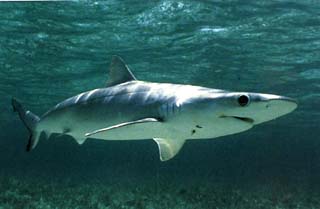Atlantic Sharpnose Shark

Appearance: Small shark. Long, parabolic snout, with long upper furrows. Nostrils are far apart. Big eyes. Origin of first dorsal fin before or slightly before the free rear ends of the pectoral fins. Origin of second dorsal fin above midbase of anal fin or just in front of its insertion. No spiracles.
Coloration: Grey to grey-brown with white ventral surface. Adults have small light (white) dots on body, white margins on pectoral fins and and dusky dorsal fin tips.
Distribution: Western North Atlantic: New Brunswick to Florida, Bahamas and Gulf of America.
Biology: Abundant. Lives over continental shelf, mainly in shallow water (less than 30 ft) but has been found down to 900 ft. Tolerant to different salinities, and can be found in estuaries and river mouths. During winter months they migrate into deeper waters. Sharpnose sharks can form big schools of same sex and size.
Feeding: Small fishes, crustaceans and molluscs. Size: Average size between 2.5 to 3 ft, maximum total length about 4 ft.
Reproduction: Gives birth to live young (viviparous, with yolksac-placenta). Normally 4 to 6 pups per litter, although can vary from 1 to 7. Pups are born in unprotected nursery grounds. Fast growth, reaching maturity after 3 to 4 years with a size of 2 to 2.5 ft. (males) and 2.5 to 3 ft. (females).
Similar species: None. This is the species locally called "sand sharks"
Population Status: Common.
Danger to humans: Harmless (although any species of captured shark can - and will try - to bite a careless angler).





